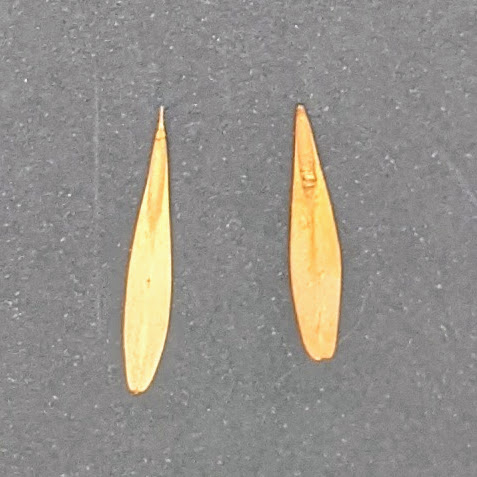Fraxinus uhdei
- Admin

- Jul 21, 2021
- 3 min read
Updated: Aug 29, 2021

At West Valley College, this tree provides graceful elegance and light shade along the North Walk. The allée or formal row of trees framing the walk soar high above most nearby trees, a nod to more formal designs found on campuses elsewhere. American elms, London plane trees, and others lend themselves to this design purpose, and so the evergreen ash takes its place among these formidable trees, in part because of its regional interest as a native to temperate regions of Mexico.
F. uhdei can be readily found in Southern California, where several reports, including from CAB International, reference evidence of invasiveness in riparian corridors. Hawaii, too, is having their challenges with invasiveness.
Because the Bay Area is becoming quite mild, we find evergreen ash performing well here but not found to be an invasive problem.
For California, "evergreen ash" can be misleading. There are times when this tree will shed some or all its leaves, so we more accurately define it as semi-evergreen...for now. As our climate continues to warm, F. uhdei might find the change to its liking. This is why it may be a good choice to invest in long-term, but generally ash trees have some challenges.
Years ago, Modesto ash, or Fraxinus velutina 'Modesto', was all the rage as a street tree due to its brilliant golden yellow autumn leaves. It was not until they were already well established along many city streets when arborists discovered their flaws, namely their vulnerabilities to pest, diseases, and weak wood causing splitting. Over the years, countless have disappeared. They are still around; the street where I grew up in Palo Alto still has them, and they appear to be thriving for over fifty years. I will digress further to observe that even weak-wooded trees can do well in the right place and with proper corrective pruning. And that takes us back to our subject, the evergreen ash.
There are some advantages to specifying evergreen ash, or other ashes as well. They are fast growing, which for our quick gratification culture will have a formidable presence early after a project's completion. This is one reason, however, why ash are weak wooded, so any installation should also include monitoring and corrective pruning over time. Ash trees tend to be heat tolerant, another desirable trait as our summers are increasingly warmer. Evergreen ash does have its limits with heat; according to Sunset, leaves may burn on exceedingly hot, windy days when we also hear of mass traffic jams heading to Santa Cruz beaches. I question that observation, simply because evergreen ash can be found in Arizona's heat. Another advantage, particularly in California, is their resistance to oak root fungus, a perennial problem for other trees including, you guessed it, oaks.
West Valley College Campus Location: Fraxinus uhdei
North Walk (and other locations)
Lat: 37°15'53.74"N
Long: 122° 0'41.90"W
facts
Botanical Name: Fraxinus uhdei
Fraxinus: Traditional Latin name for ash tree
Uhdei: Honoree, 19th century merchant and naturalist Carl Adolph Uhde
Common Name: Evergreen ash; shamel ash; tropical ash
Family Name: Oleaceae
Origin: Mexico
design considerations
Positioning: Lawn, background, away from riparian corridors, large-scale campus or parks
Garden Themes: Sub-tropical, Mediterranean
Uses: Allée, shade, overstory, street (careful of limb weakness and concrete compatibility)
identifying characteristics
Type: Evergreen, semi-evergreen to deciduous tree (pending location/climate)
Form: Oval, round, vase
Texture: Medium
Size: 60' wide by 80' tall
Outstanding Feature(s): Function as shade tree
Bark: Gray, furrowed
Leaf:
Type: Odd pinnately compound
Arrangement: Alternate
Shape: Leaflets: lanceolate
Margin: Entire
Color: Dark green. No significant fall color
Surface: Smooth
Flower: Spring. Inconspicuous
Fruit: Summer into Autumn. Dense clusters of drooping samaras, light green to tan
cultural requirements, tolerances & problems
Sunset Zones: 9, 12-24
USDA Zones: 8-10
Light: Full sun to partial shade
WUCOLS SF Bay Area Hydro Zone: Moderate
Soil:
Texture: Clay, loam, sand.
Moisture Retention: Consistent but light moisture
pH: Highly acidic to highly alkaline
Tolerances: Lawn, oak root fungus, deer
Problems: Limb breakage
Branch Strength: Weak
Insects: Aphids, scale, white fly
Disease: Texas root rot, verticillium
citations & attributions
Invasive Species Compendium. "Fraxinus uhdei." CAB International, Wallingford. Accessed on July 21, 2021, from https://www.cabi.org/isc/datasheet/24559.
Norris Brenzel, K. (Ed.). (2012). The New Sunset Western Garden Book. New York: Time Home Entertainment, Inc.
Taxon Report. "Fraxinus uhdei." Calflora, Berkeley. Accessed on July 21, 2021, from https://www.calflora.org/app/taxon?crn=8655.
Urban Forest Ecosystems Institute SelecTree. "Fraxinus uhdei Tree Record." 1995-2021. Cal Poly State University, San Luis Obispo. Accessed on July 21, 2021, from https://selectree.calpoly.edu/tree-detail/640.
Water Use Classification of Landscape Species. "WUCOLS IV Plant List." University of California, Division of Agriculture and Natural Resources, Davis. Accessed on July 21, 2021, from https://ucanr.edu/sites/WUCOLS/Download_WUCOLS_IV_List/.
Photos:
All photos by TELCS.














Comments